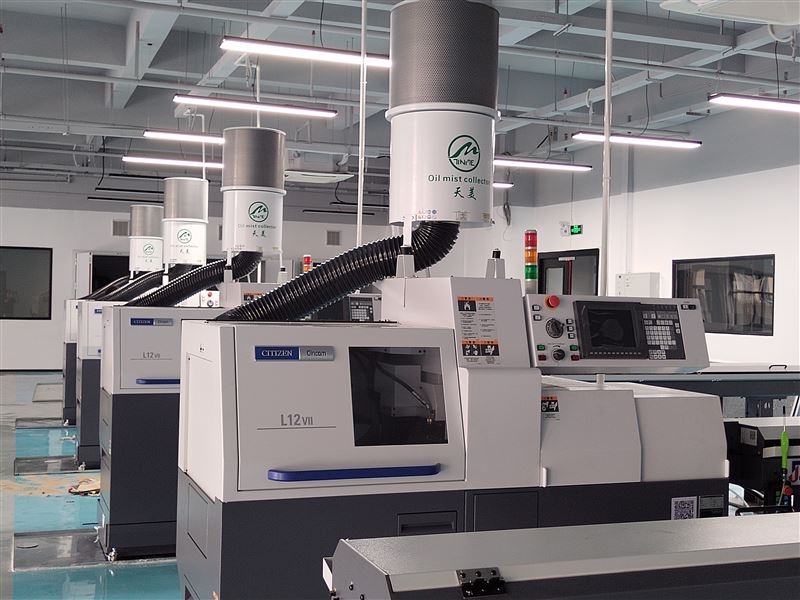Conquering Workplace Chaos: How Oil Mist Collectors Revolutionize Industrial Environments & Protect Your Assets
The relentless hum of machine tools forms the heartbeat of modern manufacturing. Yet, this vital activity comes with an unseen adversary: oil mist. Generated during high-speed machining processes like milling, turning, and grinding, this pervasive aerosol contaminates air, coats surfaces, and threatens worker health. Enter the Industrial Oil Mist Collector – not just a filter, but an indispensable cornerstone of intelligent factory operations. Dive into the advanced engineering that transforms smoky workshops into clean, efficient, and safe production hubs.
Beyond Filtration: Unpacking the Sophisticated Engineering
Modern oil mist collectors are feats of specialized engineering designed for the demands of heavy industry. Here’s what sets them apart:
-
Multi-Stage Air Purification Warfare: The core strength lies in a rigorously tiered filtration approach:
- Pre-Filtration (Capture Stage): High-velocity mist laden with coarse droplets (typically >10 microns) is immediately drawn into the collector via high-volume fans creating powerful negative pressure. These larger particles impact durable metal mesh or synthetic pre-filters, capturing bulk liquid and preventing premature clogging of finer stages.
- Centrifugal & Baffled Separation (Agglomeration Stage): Advanced designs often incorporate inertia or impaction techniques before main filters. Centrifugal force throws droplets radially outward onto specially designed, non-wettable baffles or separator walls. Here, tiny micron-sized aerosols coalesce into larger, drainable droplets – significantly reducing the load on downstream filters.
- High-Efficiency Coalescing Filtration (Final Purification): Fine mist (<1 – 10 microns) meets primary filter media (e.g., borosilicate micro-glass fiber or specialized synthetic media). Through intricate mechanisms including Brownian diffusion, direct interception, and inertial impaction, sub-micron aerosols collide, merge (coalesce), grow large, and drain away. Efficiency rates typically exceed 99.97% on 0.3-micron particles (MERV 16+ equivalent).
- Optional Final Safety Net (HEPA/ULPA): In sensitive applications (pharmaceuticals, optics, high-precision aerospace), ultra-fine particulate safety filters capture any potential residual emissions.
-
The Intelligence Factor: Modern collectors integrate sophisticated control systems far beyond a simple on/off switch:
- Variable Frequency Drive (VFD) Fans: Dynamically adjusts fan speed based on real-time differential pressure across filters, maintaining optimal airflow while minimizing energy use by up to 60%.
- Advanced Sensory Networks: Optical mist density sensors, pressure transducers, motor current monitors, and temperature probes provide continuous health diagnostics.
- Predictive Maintenance & Remote Oversight: Cloud-connected IoT platforms analyze sensor data, predict filter life, notify technicians of required service, and allow remote monitoring/control of multiple units across a facility. Touchscreen HMIs allow easy mode selection and data visualization.
-
Material & Design Resilience: Heavy-duty enclosures, often crafted from coated steel or antimicrobial stainless steel, withstand industrial corrosion. Sealed motors rated for continuous operation prevent internal contamination. Quiet-running ECM (Electronically Commutated Motor) technology drastically reduces noise pollution, often operating below 68 dBA. Optimized aerodynamic ducting minimizes pressure loss and turbulence within the unit.
- Integrated Resource Recovery: More than just trapping oil mist, efficient collectors become resource recyclers. Captured coalesced oil typically drains into accessible, large-volume silicone-coated tanks. High-quality coolant oil, once separated from water emulsions through filtration, can often be reclaimed and filtered for safe reintroduction into CNC reservoirs, significantly reducing waste disposal costs and coolant purchases. Some systems feature automated pump-out systems for centralized coolant recycling.
Powering Performance: Core Operation Sequence Revealed
Understanding the collector’s internal choreography explains its effectiveness:
- Induction: High-torque fans generate substantial negative pressure airflow, actively pulling dispersed oil mist aerosols directly from CNC machine enclosures or localized hoods through dedicated ductwork.
- Strategic Velocity Reduction: Upon entry, airflow enters a deliberately expanded chamber. This critical deceleration allows the largest mist particles to lose momentum and fall out under gravity into the drain pan (initial liquid removal).
- Mechanical Coalescing & Separation: Air then passes through specialized coalescence mesh or engineered baffles where inertial impaction forces micro-droplets to collide and enlarge, readily draining.
- Deep Primary Coalescing Filtration: Pre-treated air encounters the primary fine mist filter element(s). Here, the intricate dance of diffusion, interception, and coalescing occurs. Virually all remaining sub-micron oil particles agglomerate on the fiber matrix, grow heavy, and ultimately drain as liquid.
- Final Particle Guard (Optional Enhanced Stage): A secondary filter (e.g., box-pleated HEPA) captures any residual fine particles, especially critical for protecting delicate downstream equipment or stringent environmental areas.
- Clean Air Reintroduction: Purified, lubricant-free air is discharged back into the workshop environment or through an optional duct to outside via exhaust louvres. This step actively improves overall indoor air quality.
- Continuous Drainage & Resource Reclamation: Coalesced oil continuously flows into the integrated tank. Advanced automated drainage systems, triggered by level sensors, pump recovered coolant/oil mixtures to central recycling skids for filtration and re-use. Manual tanks require periodic emptying for reclamation.
Beyond Metal Chips: Ubiquitous Applications Driving Industrial Evolution
Oil mist collectors are the unsung heroes across critical sectors demanding pristine air and precision:
- Metalworking Mastery: Essential across CNC machining centers (milling, turning, drilling), EDM (Electrical Discharge Machining), grinding, broaching, and honing stations – protecting precision machines from oil ingress, enabling clear visibility on OMVs (Optical Measurement Vision) systems, and preventing slip hazards on floors.
- Automotive Engineering Excellence: Found in high-volume transmission line machining, flexible engine block production cells, gear manufacturing hubs, cylinder head milling centers, and turbocharger component processing. Ensures certified product quality meets AS/ISO standards and safeguards expensive components.
- AeroSpace Precision & Safety: Critical within CNC-based turbine blade machining centers (5-axis milling), composite material trimming facilities, high-integrity hydraulic component manufacturing cells, and avionics clean room machining zones. Protects sensitive composite resins and prevents fire risks near high-heat processes.
- Semiconductor & Electronics Manufacturing: Shielding sensitive photolithography equipment and assembly processes within Class 1000 to Class 10 cleanrooms from airborne hydrocarbon contamination degreasers and lubricants used in wafer dicing/grinding.
- Medical Technology & Device Fabrication: Maintaining ultra-clean environments during the precision machining of orthopaedic implants and surgical instruments from titanium or specialized polymers.
- Food & Pharmaceutical Processing: Protecting packaging machinery operating mechanisms and conveyor systems from lubricant overspray and minimizing particulate risks in regulated environments (FDA/GMP zones), especially where minimal lubricant formulations (MQL) are prevalent.
A modern, compact mist collection system integrated with CNC machining equipment.
Lifeline to Longevity: Mastering Advanced Maintenance Protocols
Proactive upkeep unlocks peak operational lifespan (often 10+ years) and maximum efficiency:
-
Operator-Level Daily/Weekly Tasks:
- Visual exterior check for unusual vibrations, leaks, or alarm indicators.
- Empty drains/reclaim skids; ensure tanks are far below fill-line peaks.
- Inspect pre-filters & wash/spray-clean reusable coarse metal mesh filters. Verify input/output ducting remains open and undamaged.
- Wipe down sensors & critical control panels; maintain a clean intake environment.
-
Scheduled Technician Maintenance (Monthly/Bi-Annual):
- Diagnostic sensor calibration for maintenance counter accuracy and efficiency.
- Inspect pressure differential readings and fine filter saturation levels (replacing primary filters at ΔP threshold of 2.5-3.0" w.g. typically).
- Comprehensive motor and bearing health assessment with vibration analysis. Inspect wiring, control box components, and solenoid valves.
- Detailed cleaning of internal coalescer stages using manufacturer-approved methods without damaging specialized coatings.
- Replace consumable HEPA/safety filters as scheduled (often annually).
-
Annual Deep Technical Evaluation:
- Calibration of pressure monitors and flow sensors to HVACR engineering standards.
- Thorough inspection of structural seals, internal cyclone/baffle assembly integrity, and mounting stability controlling harmonic resonances.
- Fan impeller balancing testing and comprehensive electrical safety audits per NFPA 70E and IEC standards.
- Full review of system performance historical data logs utilizing cloud-based collector management software to identify operational behavior trends and recommend adjustments.
- Data-Driven Filter Strategy: Track and log run-time hours and pressure drops religiously. Adjust replacement frequency based on facility-specific mist production levels – some extreme environments discharge filters weekly. Employ RFID-enabled filters coupled with collector reader systems for automated life tracking.
Innovating Tomorrow: Smart, Sustainable Revolution Ahead
Oil mist collection technology is undergoing transformative changes propelled by digitalization and sustainability imperatives:
- AI-Powered Adaptive Control: Systems using neural networks that integrate machine tool operation data and mist density sensors to predictively control fan speeds and filter regeneration cycles, optimizing energy consumption per workpiece signal (Joules/dm³).
- Closed-Loop Coolant Ecosystem Integration: Direct, automated integration with central coolant distribution/recycling hubs. Collected mist oil undergoes microfiltration, water separation via skimmers, and biological treatment, continuously replenishing machine tool systems towards net-zero waste generation on production lines.
- Advanced Nanofiber Filtration: Next-gen media employing electrospinning production enables ultra-low resistance nano-fiber filters with enhanced particle holding capacity (dust loading ≥ 500g/m²) and sub-0.1-micron filtration efficiency exceeding 99.99%, lowering lifetime energy expenditure.
- Compact, Direct-Machine Integration: Miniaturized collector composites embedded seamlessly within CNC tool frames or mounted directly onto robotic arm machining centers, eliminating ducting losses & installation customization costs.
- Hydrogen-Powered & Low-Voltage DC Systems: Incorporation of future-proof low-emission power systems utilizing hydrogen fuel cells and efficient DC motors targeting 80% energy usage reduction versus conventional solutions.
- Industrial Metaverse Integration: Creation of digital twins synchronized with physical collectors enables immersive VR training for technicians and enables engineers to simulate airflow patterns across entire shop floors for optimized collector placement using Computational Fluid Dynamics (CFD).
Prioritizing People and Performance
Oil mist collectors transcend mere compliance tools. They are vital investments safeguarding critical assets—human and mechanical. By eliminating respiratory health hazards (reducing risks of asthma, bronchitis, and long-term lung issues), improving workshop visibility for enhanced safety, preventing costly machine lubricant contamination, reducing slip-and-fall incidents, and extending CNC component lifespan, they generate rapid ROIs. Reclaiming valuable coolants and cutting disposal costs adds significant economic uplift. Modern manufacturing thrives on precision, speed, and efficiency – all impossible within a haze-filled oil mist. Transforming this challenge into a controlled process through cutting-edge collection technology unlocks higher quality output, extended machine lifecycles, lower operational overhead, and crucially, a healthier production environment where innovation flourishes. The evolution towards smarter, integrated, and hyper-efficient mist collection signifies not just a response to regulation, but a strategic lever driving competitive advantage across the global industrial ecosystem. Invest in clarity; invest in the future.

















